If you dream of warm Mediterranean days beside sapphire-blue waters and beneath the shade of historic walled towns, Croatia is where those fantasies come to life.
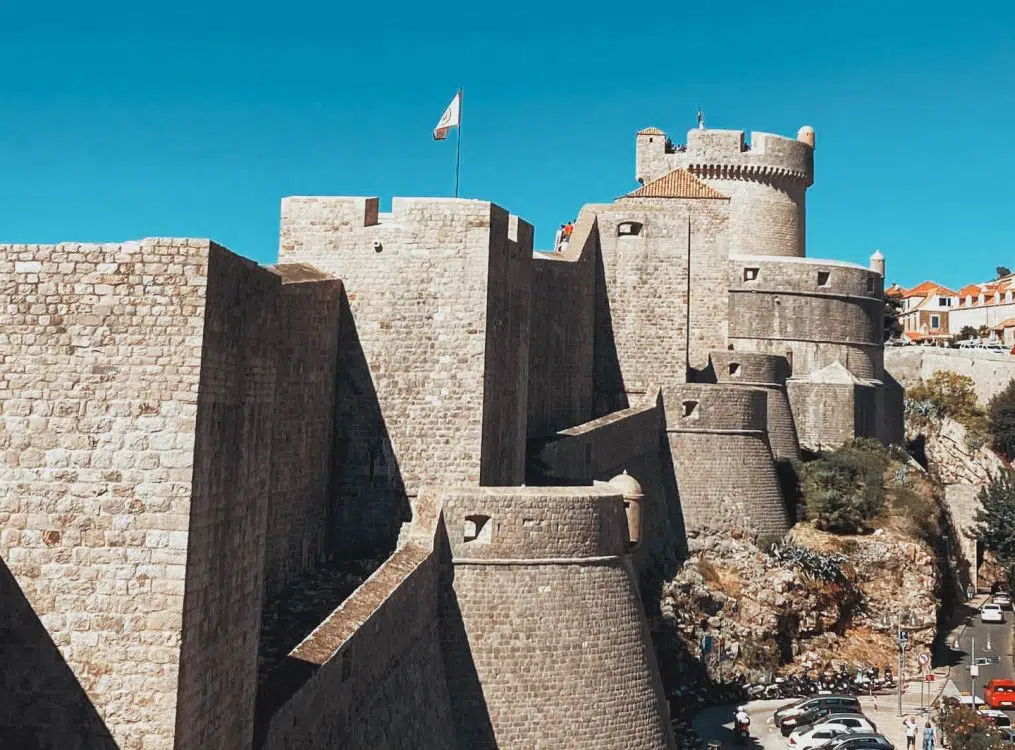
No visit to Dubrovnik is complete without walking the spectacular city walls that surround its historic centre. These impressive fortifications are among the best preserved in the world and are the defining symbol of the city. From atop the walls, you’ll enjoy breathtaking views of the old town and the sparkling Adriatic Sea. From the sea, the contrast between the soft pinkish-grey stone and the vivid blue water is striking, while from above, the labyrinth of steeples and terracotta rooftops feels straight out of a fairy tale—or a scene from Game of Thrones.
Dubrovnik’s first city walls were constructed in the 9th century. By the mid-14th century, the defences were reinforced with 15 square forts. In the 15th century, facing threats from the Turks, the city further fortified its defences, enclosing the old town with walls that stretch 2km and rise up to 25m high. The land-facing side of the walls is up to 6m thick, while the sea-facing side ranges from 1.5m to 3m.
In the past, entry to Dubrovnik was through two main gates: Pile Gate to the west and Ploče Gate to the east. Both featured drawbridges, which were raised at sunset when the gates were locked and the keys handed to the rector. A third entrance, Buža Gate, was added to the northern wall in 1907.
The most remarkable gate is the Pile Gate, constructed in 1537, which remains the primary entrance. Above the Renaissance portal stands a stone statue of St Blaise, the city’s patron saint, holding a model of Dubrovnik. After passing through the outer gate, visitors enter a courtyard with a ramp and steps leading to the inner gate, built in 1460 and crowned by another statue of St Blaise, sculpted by Croatian artist Ivan Meštrović (1883–1962).
Access points to the city walls are located near Pile Gate, Ploče Gate, and the Maritime Museum. For crowd control, all visitors must walk in an anticlockwise direction. During peak times, the route may feel slow and crowded, but the sweeping views of Dubrovnik and the sea more than make up for it.
As you walk, you’ll catch charming glimpses into hidden gardens and courtyards tucked within the city’s quieter residential areas.
Starting from the Ploče Gate entrance, you’ll soon reach St Luke’s Tower (1467), overlooking the Old Harbour and Fort Revelin. The northern wall, facing inland, is the highest point of the route and leads to the round Fort Minčeta at the northwest corner. Completed in 1464 by Juraj Dalmatinac (famed architect of Šibenik’s cathedral), the fort offers unbeatable rooftop views. You’ll also notice rooftops restored after the 1990s shelling—newer terracotta tiles mark buildings that suffered damage.
From Fort Minčeta, the path leads downward over the Pile Gate, narrows to single file, and climbs to Fort Bokar in the southwest. The seaside stretch of wall offers a few café-bars and souvenir stalls before ending at Fort St John by the Old Harbour entrance.
Dubrovnik’s walls and forts are iconic filming spots from Game of Thrones. Fort Minčeta was used as the exterior of Qarth’s House of the Undying. The seaward walls served as King’s Landing’s defences during the Battle of Blackwater, where Tyrion Lannister took command. Fort Lovrijenac (just outside the western wall) doubled as the Red Keep.
Tickets can be purchased on-site, but buying online in advance helps you avoid queues.
The walk can be physically demanding—especially in the heat. There’s minimal shade, and water sold along the way tends to be overpriced, so come prepared.

Croatia’s Unrivaled Natural Wonder
Plitvice Lakes National Park is Croatia’s most breathtaking natural attraction and a UNESCO World Heritage Site. Nestled in the lush Adriatic hinterland, the park features 16 turquoise lakes cascading into each other through hundreds of waterfalls, all surrounded by dense forests and scenic cliffs. Wooden pathways and 18km of trails wind through this magical landscape, offering unforgettable views at every turn.
Veliki Slap: Croatia’s tallest waterfall at 78 meters
Kozjak Lake: The park’s largest lake, ideal for a boat ride
Šupljara Cave: An open-topped cavern with panoramic views
Galovac Lake: Surrounded by travertine-formed waterfalls
Butterfly Clouds: Especially visible in warmer months
Start at Entrance 2 for easier access to the upper and lower lakes
Combine boat rides, walking trails, and the road train to suit your fitness and time
The lower lakes take about 3 hours to explore; the upper lakes about 2 hours
No swimming allowed in the lakes to preserve the ecosystem
Spring & early summer: Full waterfalls and lush greenery
Autumn: Stunning fall foliage
Winter: Magical snowy scenery (note: limited access and no transport service)
Avoid July & August: Crowds, long waits, and reduced water flow
Buy tickets online in advance – same-day purchase not allowed
Wear comfortable walking shoes and bring water/snacks
Guesthouses in nearby villages like Korana offer a cozy stay
Official hotels are convenient but basic; campsites also available
Whether you’re hiking through forest trails, crossing over waterfalls on wooden footbridges, or simply soaking in the silence of nature, Plitvice promises an unforgettable escape into one of Europe’s most extraordinary landscapes.
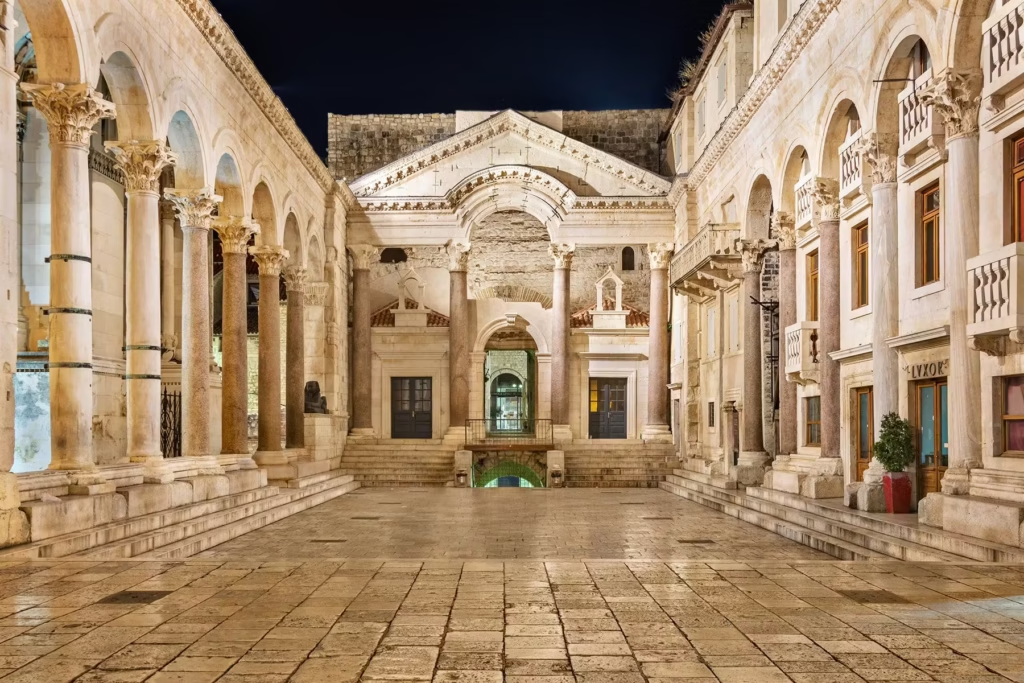
Where Ancient Rome Meets Modern Life
Set along Split’s vibrant harbor, Diocletian’s Palace is not your typical ruin. This sprawling Roman complex, built for Emperor Diocletian in the 4th century AD, isn’t a museum – it’s the pulse of the city. Its labyrinth of streets buzzes with shops, homes, cafes, and bars, all enclosed within some of the most impressive Roman architecture still standing today.
What once served as an emperor’s retirement home, military fortress, and fortified town now forms Split’s Old Town. Though the original sea-facing structure is hidden by today’s waterfront promenade, look up to see ancient arches and columns still towering over modern life.
Constructed from white Brač stone, with imported marble from Italy and Greece and sphinxes from Egypt
Built between AD 295 and 305, it was the chosen retreat of the only Roman emperor to voluntarily step down
Each of the palace’s cardinal walls has a gate named after a metal:
Golden Gate (North) – The grand ceremonial entrance
Bronze Gate (South) – Once opened directly to the sea, now the main entrance from the Riva
Silver Gate (East)
Iron Gate (West)
The Decumanus (Krešimirova Street) runs straight through the center, dividing the emperor’s quarters in the south from the military and servant areas in the north.
Beneath the palace lies a haunting network of substructures, once used for storage. Today, its central corridor is lined with souvenir stalls, while ticketed chambers lead to eerie vaulted spaces used in Game of Thrones as Daenerys’ dragon lair.
Cathedral of St Domnius: Once Diocletian’s mausoleum, now Split’s cathedral. Its octagonal base and 24 original columns remain intact. The striking bell tower (13th–16th centuries) offers stunning views if you can brave the climb.
Temple of Jupiter: Now a baptistery, this former Roman temple features a vaulted ceiling, decorative friezes, and a powerful bronze statue of St John the Baptist by Ivan Meštrović.
Combined tickets include access to the cathedral, crypt, treasury, and Temple of Jupiter. The bell tower requires a separate ticket.
Today, over 3,000 people live within the palace walls. Its 220 buildings form a maze of alleyways and courtyards where daily life continues as it has for centuries:
Laundry flutters above ancient streets
Children play football against Roman stone
Locals sip coffee and watch life unfold from their windows
Diocletian’s Palace is not just a monument—it’s a living, breathing part of Split where history and modernity collide in the most captivating way.
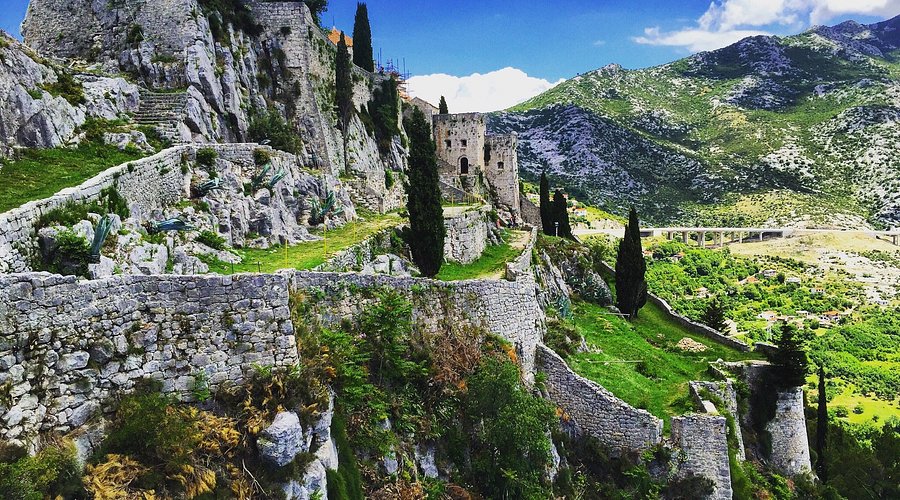
A Hilltop Stronghold Steeped in History and Epic Views
Rising high above Split, Klis Fortress stretches dramatically along a limestone ridge at 1260ft (385m), offering panoramic views of the city and the Adriatic Sea. With origins dating back over 2000 years, its long, narrow form tells the story of constant adaptation, war, and resilience.
Klis has played a key role in the defense of Dalmatia for centuries:
Founded by the Illyrians in the 2nd century BCE
Conquered by Romans, then served as the seat of medieval Croatian ruler Duke Trpimir
Resisted Ottoman sieges for 25 years before falling in 1537
Briefly retaken in 1596 and finally conquered by the Venetians in 1648
Inside, a small museum housed in a Venetian-era armory showcases weapons, armor, and a mock-up of the traditional Uskok warrior attire. Though the museum panels are lengthy, they offer detailed insights into the fortress’s turbulent past.
To reach the heart of the fortress, you’ll pass through three historic gates:
Main Gate (Austrian, 1820s) – Ticket office and entrance
Medieval Main Gate – Refashioned by the Austrians
Upper Gate – Originally medieval, rebuilt by the Venetians in 1763
These layers of fortification reflect centuries of architectural evolution by Illyrian, Roman, Ottoman, Venetian, and Austrian hands.
At the uppermost point stands St Vitus’ Church, a modest square structure once transformed into a mosque during the Turkish occupation. From here, the views stretch across Split and the Dalmatian islands—a breathtaking reward for the climb.
Klis Fortress gained global fame as the city of Meereen in Game of Thrones, where Daenerys Targaryen exacted justice in season four. An exhibition in an 18th-century gunpowder chamber displays stills from the show to help fans visualize the transformation.
Location: 12km (7 miles) northeast of Split
Transport: Easily reachable by local bus from Split
Best Time to Visit: Mornings in summer to avoid the heat – there’s minimal shade
Local Tip: After exploring, enjoy a meal at one of Klis’ famous spit-roast lamb restaurants
Bonus: With a car, combine your visit with the nearby Roman ruins of Salona for a day full of history
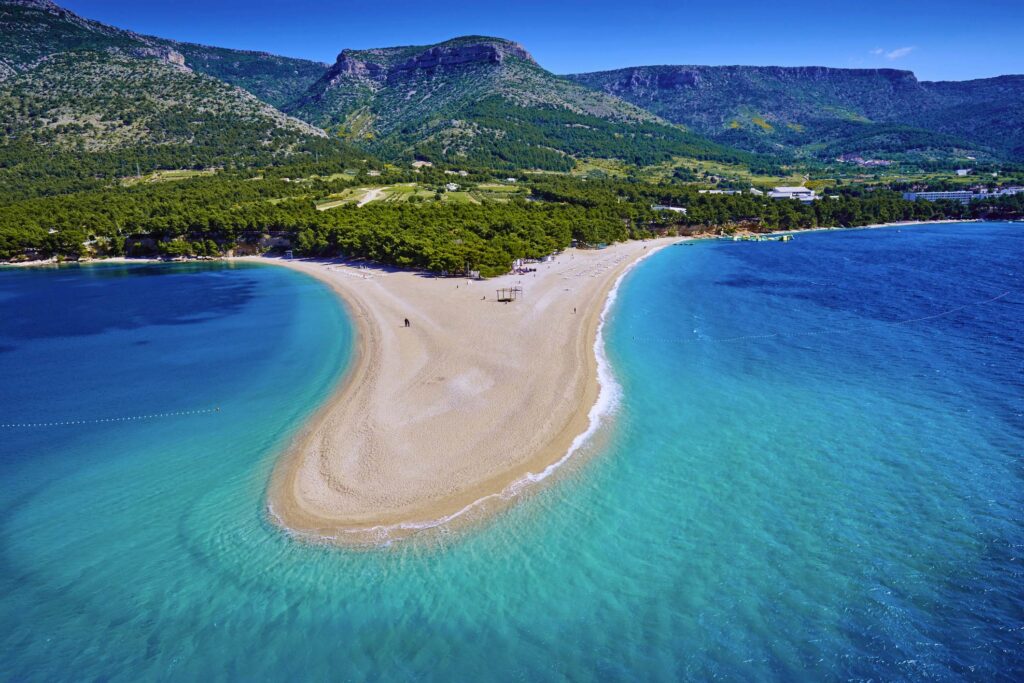
A Golden Cape Where Nature Never Stands Still
Located just outside the charming town of Bol on the island of Brač, Zlatni Rat is Croatia’s most photographed beach—and for good reason. This stunning white-pebble spit juts 400m into the Adriatic like a golden tongue, constantly reshaped by wind and waves. The pine forest backing the beach and the dramatic cliffs above create one of the most picturesque settings in Dalmatia.
Despite the popularity and summer crowds, the beach maintains a peaceful allure, especially if you visit early in the morning or late in the afternoon to avoid the strong winds. There’s also a small nudist section just west of the cape.
Bol is one of Croatia’s premier windsurfing spots, with Zlatni Rat at the heart of the action. The reliable maestral wind (April–October) peaks in early afternoons, making it ideal for thrill-seekers.
Best months: Late May to early June and late July to early August
Big Blue Sport (700m east of Zlatni Rat) offers:
Windsurf gear rental: €18/hour or €40/half-day
Beginners’ windsurf course (6 hours): €135
Paddleboards, kayaks, and mountain bikes also available
The top choice nearby is Mali Raj, a relaxed tavern just above the beach car park. With its shady garden and alfresco vibe, it’s perfect for savoring Dalmatian seafood classics like grilled squid and fresh fish. For lighter options, beachside bars serve refreshing drinks and snacks all day long.
The scenic Put Zlatnog Rata promenade connects the beach with Bol’s historic center, bus station, and ferry port. This shady, pine-lined walkway stretches 1.5km along the coastline and is dotted with sculptures, summer stalls, and ice cream vendors.
Walking: 20-minute stroll from Bol
Taxi boats: Frequent from Bol’s old harbor
Driving: Parking available close to the beach
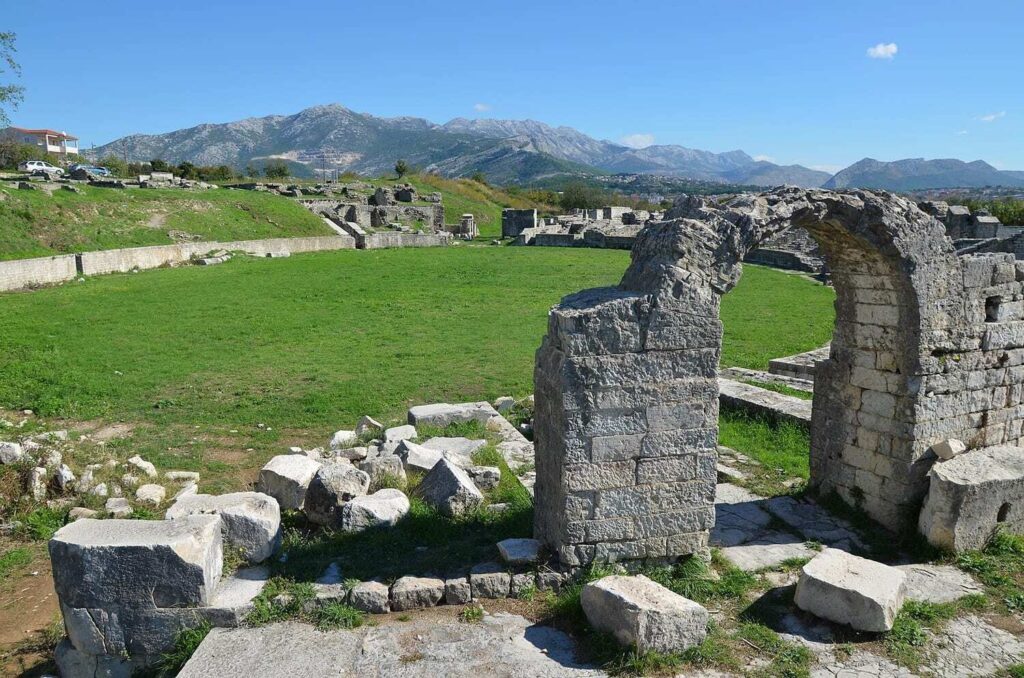
Walk Through the Ruins of Croatia’s Most Important Ancient City
Just northeast of Split, at the foot of the mountains, lie the ruins of Salona—the most significant archaeological site in Croatia. Once the bustling Roman capital of Dalmatia, this sprawling ancient city offers a captivating journey through time, surrounded by peaceful vineyards and cypress-lined paths.
Start your exploration at Tusculum, near the northern entrance. Built in 1898 by pioneering archaeologist Monsignor Frane Bulić, this villa served as a research base and now houses a small museum with a Roman-style drawing room showcasing early excavations.
First mentioned in 119 BC as an Illyrian settlement, Salona was taken by the Romans in 78 BC and rose to prominence under Emperor Augustus as the administrative center of Dalmatia. Its strategic location later influenced Emperor Diocletian to build his palace nearby. But the city’s grandeur ended in the 7th century when Avars and Slavs destroyed it, forcing survivors to seek refuge in Diocletian’s Palace and nearby islands.
Despite centuries of decline, many impressive ruins remain in situ, while others are preserved in Split’s Archaeological Museum.
Manastirine: Scattered sarcophagi and ruins of an early Christian basilica mark the cemetery where Christian martyrs were buried before the faith was legalized.
Episcopal Centre: A short walk from Tusculum, this complex includes a 5th-century three-aisled cathedral, an octagonal baptistery, and Bishop Honorius’ basilica in the form of a Greek cross.
Porta Caesarea: The monumental eastern city gate, with visible wheel grooves and remains of a Roman aqueduct that once supplied water from the Jadro River to both Salona and Split.
Public Baths: Just behind the basilica, remnants of Roman thermal culture.
To the west lies the 2nd-century amphitheatre, once capable of holding 18,000 spectators. Though partially destroyed by the Venetians in the 17th century to prevent its use by Ottoman raiders, the structure still hints at Salona’s former scale and significance.
Along the main path to the amphitheatre, visit the cemetery of Christian martyrs and the Five Martyrs Basilica, built in their memory.
To the left, amid orchards and vineyards, lie the scant remains of the Forum, a Roman theatre, and a Temple of Dionysus—ghosts of the city’s vibrant civic and religious life.
Salona is just a short bus ride from Split.
Split City Bus 1 departs every 30 minutes from Trg Gaje Bulata
Tickets: 13KN one-way / 22KN return
The bus goes directly to the on-site parking lot
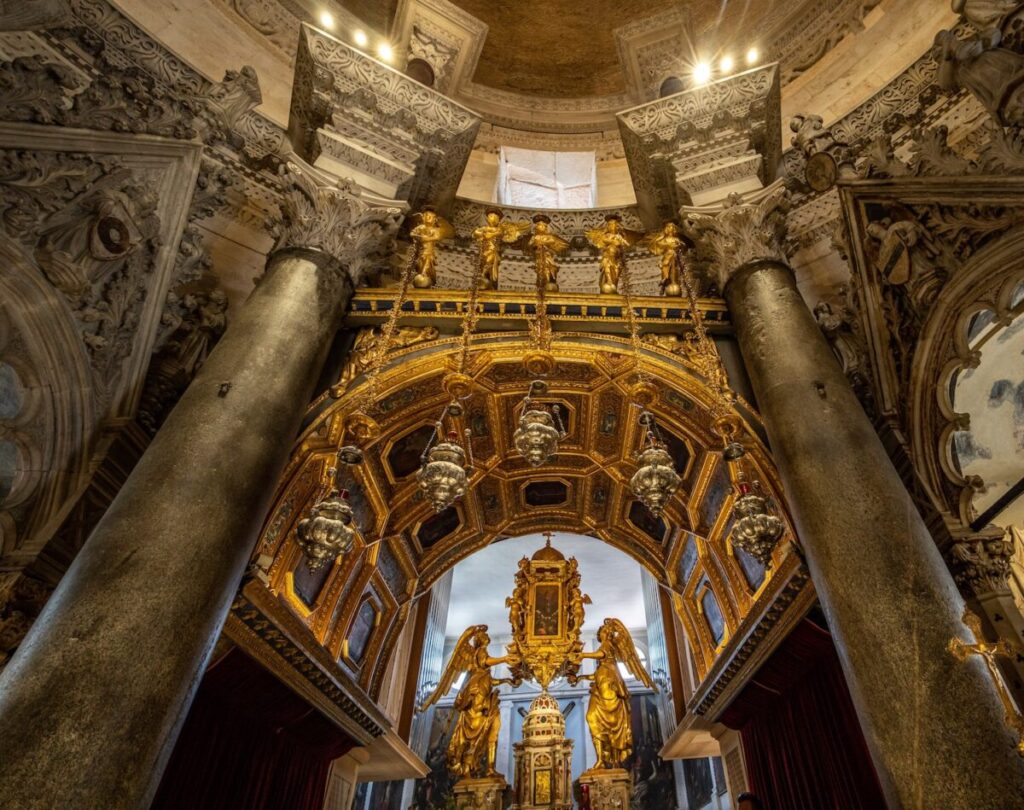
A Roman Mausoleum Transformed into Croatia’s Spiritual Heart
In the heart of Split’s historic Diocletian’s Palace stands one of the best-preserved Roman buildings in the world — the Cathedral of Saint Domnius. Originally built in AD 311 as the mausoleum of Emperor Diocletian, infamous for persecuting Christians, this octagonal structure is rich in irony: by the 5th century, Christians had destroyed Diocletian’s sarcophagus and converted his tomb into a church dedicated to Saint Domnius, one of his victims.
A single ticket grants entry to the cathedral, its crypt, treasury, and the Temple of Jupiter (now the baptistery).
Bell tower admission is sold separately.
In summer, access is via the sacristy on the right-hand side, which also houses the treasury — a remarkable collection of reliquaries, icons, manuscripts (including in Glagolitic script), and richly embroidered church robes. In the off-season, visitors enter through the main door, but the treasury remains closed, and tickets are 10KN cheaper.
The original Roman colonnade of 24 columns still encircles the building, giving the structure its classical form.
The Romanesque bell tower, a much later addition (13th–16th centuries), collapsed and was rebuilt in 1908. Brave climbers are rewarded with panoramic views of Split’s rooftops—but beware the steep stone and exposed metal stairs.
The domed interior is a study in Roman elegance and medieval reverence, with two tiers of Corinthian columns and a frieze that remarkably still displays Diocletian and his wife.
Main altar: To its left is the altar of St Anastasius (1448), sculpted by Juraj Dalmatinac, featuring the acclaimed relief The Flagellation of Christ — a Dalmatian Gothic masterpiece.
Choir stalls: Dating to the 13th century, these are the oldest Romanesque choir seats in Dalmatia.
Right-hand altar: Crafted in 1427 by Bonino da Milano.
Vault: Adorned with frescoes by Dujam Vušković.
Entrance doors: Don’t miss the wooden doors by Andrija Buvina, carved in the 13th century. Their 28 Romanesque panels depict scenes from the life of Christ in miniature-like detail.
Accessed via an exterior door on the cathedral’s right side, the crypt is a cool, atmospheric chamber dedicated to St Lucy. Its eerie quiet and stone simplicity offer a sharp contrast to the grandeur above.
Directly opposite the main entrance, the New Research on Split Cathedral exhibition is free and offers insights into the engineering and historical restoration of this iconic structure — perfect for architecture lovers and history buffs.
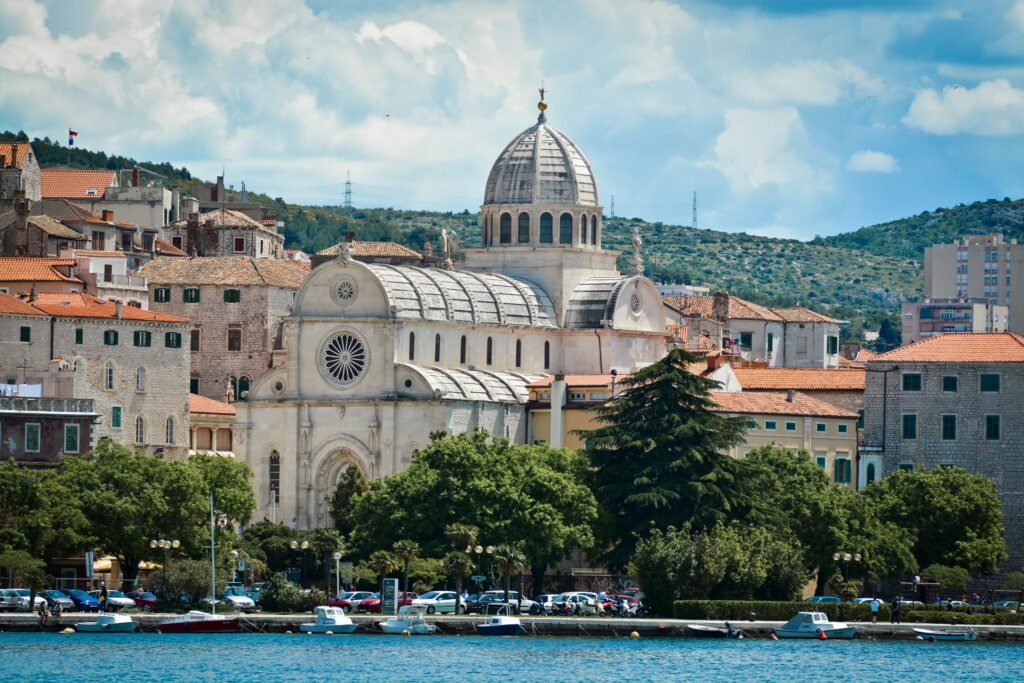
A World Heritage Masterpiece by Juraj Dalmatinac
The Cathedral of St James in Šibenik is more than a place of worship — it’s the crowning architectural jewel of the Dalmatian coast and a UNESCO World Heritage Site. Designed primarily by the brilliant Juraj Dalmatinac, this remarkable structure stands as the world’s largest church built entirely of stone, using no bricks or wooden supports.
Constructed from gleaming white limestone sourced from the islands of Brač, Korčula, Rab, and Krk, the cathedral’s harmony of interior and exterior symmetry is one of its most unusual and striking features.
Construction began in 1431, originally led by Venetian architects.
After a decade, the project was handed to Juraj Dalmatinac, a native of Zadar, who expanded the design and introduced a transitional Gothic-Renaissance style.
Following Dalmatinac’s death, the project was completed by Nikola Firentinac, who finished the façade in pure Renaissance form.
The cathedral was finally completed in 1536.
Among the cathedral’s most memorable features is a frieze of 71 sculpted human heads along the exterior rear walls. Far from idealized saints or nobles, these are portraits of 15th-century townsfolk, carved with striking individuality — some proud, others bewildered or comically grim. Legend says the stingiest citizens got the ugliest likenesses.
On the northern side, the Lion’s Portal, created by Dalmatinac and Bonino da Milano, features two lions supporting columns on which Adam and Eve stand in awkward nudity — their expressions caught between shame and surprise.
Be sure to pick up the multilingual brochure at the entrance, which offers a self-guided tour of the interior’s treasures:
Dalmatinac’s Baptistery: A standout feature in the rear corner with an elaborately carved ceiling and a font supported by three angels.
Tomb of Bishop Šižgorić: A tribute by Dalmatinac to the man who championed the cathedral’s construction.
Altarpiece of St Fabian & St Sebastian: Painted by Filippo Zaniberti.
Gothic Crucifix: A haunting 15th-century work by Juraj Petrović, powerful in its raw emotion.
WhatsApp us